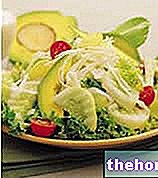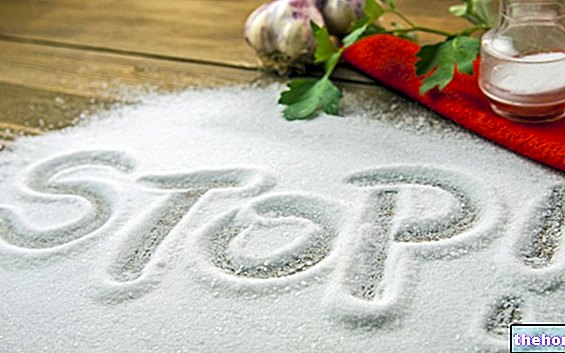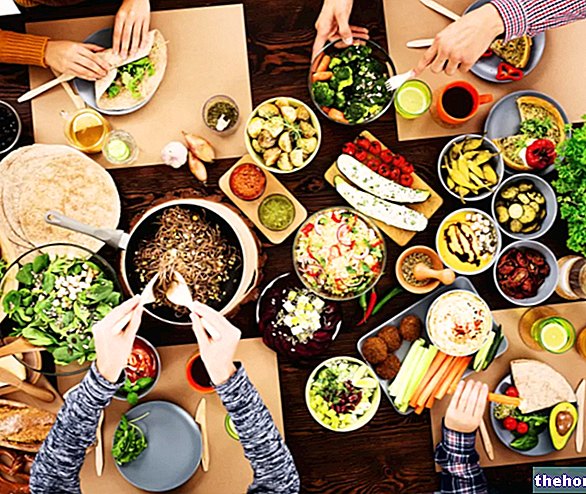Generality
Salmon is a typical fish of some subarctic and arctic areas. Its breeding, however, can also take place in more southern areas, although it is certainly NOT a characteristic animal of central-southern Europe.

Salmon, intended as a food, belongs to the 1st Fundamental Group of Foods. From a nutritional point of view, its consumption is aimed at achieving the recommended rations of: proteins, mineral salts, some B vitamins, vitamin D, vitamin A and essential fatty acids.
In the diet, salmon could be consumed on a "weekly" basis. A portion of 150-250g, at most every 2-3 days, is in fact sufficient to satisfy the basic criteria of a healthy and correct diet. In this regard, it must be specified that it is always advisable to maintain a certain variability of the diet; it is better, therefore, to avoid consuming only salmon, excluding other fishery products, since it too (like any other food) has some aspects that are not entirely positive or controversial.
It should also be added that salmon is a very high fat food; therefore, it is recommended to carefully evaluate the portions (which must be related to individual needs) and to avoid, especially in the case of overweight, its contextualization within recipes rich in seasoning fats (oil, cream, etc.).
Salmon as a Food: How to Eat It?
Salmon is a food that lends itself to various types of consumption.
In the "fresh state" its meat is delicate and pleasant (where "fresh" means "NOT processed" with preservation methods other than freezing); there are also other products obtained through alternative systems, among these, the most characteristic is the "smoking (accompanied by a light salting), but today the preservation of canned salmon by means of a preserving liquid (brine) is also quite widespread. Less consumed (and less valuable) is salmon in the form of pate.
What many ignore is that salmon are NOT consumed only the muscle and fat, or what is commonly understood as "meat". Its eggs, especially in certain places, are considered a real delicacy. Be careful though! expect a more or less "anonymous" taste, similar to that of lumpfish roe or flying fish, or whoever is accustomed to the delicate taste of Russian caviar, might be unpleasantly disappointed; salmon roe are distinguished by a hint of to say the least "explosive" of omega 3, so intense that it surpasses any other ingredient in the dish. Even some salmon offal seems edible and all in all pleasant to the taste; the liver is certainly the best known. Like the aforementioned organ of cod, of blue shark and other fish from cold seas, salmon liver is also very rich in omega 3 and, together with other parts of "waste" in the related meat trade, is often used for the formulation of food supplements. In itself, salmon liver is a fairly simple product to cook but, being an organ significantly exposed to certain contaminants, if intended for human consumption, it should be obtained from controlled animals, ignoring instead the creatures raised without respecting the disciplinary.
Returning to the meat of salmon, we briefly mention the most popular recipes in our country which, to be honest, does not boast a real culinary tradition specific to this food. Fresh salmon (even defrosted), especially in recent years, is often incorporated into raw fish recipes. Alone or in more or less exotic mixed salads, it is now a fundamental ingredient of Japanese sushi (sashimi, nigiri, oshizushi, futomaki etc.), in which it is also possible to combine it with foods that contain eggs (ikura). Always raw, salmon meat lends itself to the production of carpaccio or tartare from fresh, smoked or marinated fish. As far as cooking systems are concerned, on the other hand, steam and oven cooking are more common, with or without the use of salt crust.
There are two different kinds of smoking, one industrial (perhaps also of a chemical type, as for certain cured meats), which also includes a first salting and a subsequent vacuum, and an "other housewife. The latter" (see the video recipe) can be also carried out inside the home oven; it involves a light initial salting and is carried out "cold" (with the oven off, in which steaming wood is inserted), which is why it does not greatly prolong the shelf life of the food. On the other hand, it allows you to customize the taste according to the type of wood used.
When it comes to marinating, there are several different recipes. Some are based on the dehydration of salmon by salting (with a little sugar) and the subsequent rehydration in flavored suspensions (water, citrus juice, herbs, oil, etc.); others directly exploit flavored liquids with much higher osmotic power than that of meat (generally with very high percentages of sugar and salt), in order to "firm" the tissues while flavoring them.
In any case (since it is a food to be eaten raw) we remind you that before smoking or marinating it is always necessary to apply the lowering of temperature to avoid any risk of parasitosis.
If fresh, smoked or marinated salmon meat leaves room for culinary imagination, there is not much to specify as regards canned salmon and paté. The latter is often used in the formulation of canapes, snacks, appetizers. and sandwiches, while the one in a jar goes well with dry pasta as a filling for tortelli or as an accompanying sauce.
Quality and Controversies of Salmon in the Diet
Let us now focus on the quality of the raw material available on the market. There are various species of salmon, but in Italy (and also in the rest of Europe) Atlantic salmon is mainly consumed (binomial nomenclature: Salmo salar).
Most of the salmon present on the national banks comes from foreign aquaculture and arrives in Italy in the form of frozen, to be defrosted only before retail sale. There is therefore no valid reason to buy it "at the market" rather than in a freezer cabinet (where, moreover, it would cost even less). The only detail that REALLY makes the difference between "salmon and salmon" concerns the origin, intended as farmed fish or caught fish. low population density), it should be remembered that the salmon caught (or rather called "wild") is qualitatively better than the other. Nowadays, the composition of the feed can be varied on the basis of the product to be obtained, managing also the nutritional concentration and the pigments responsible for the coloring of the salmon; this last characteristic can also be enhanced by limiting the presence of crustaceans, instead naturally present in the diet of wild salmon (very rich, precisely, in these molecules). In practice, the meat of these fish could be "colored" by supplementing the feed with pro vitamins of type A, a bit like the salmon trout. Remember that the latter is NOT a hybrid species, but a rainbow trout with pink meats obtained by feeding the fish with flours particularly rich in carotenoids.
Unfortunately, wild salmon fishing is NOT sufficient to meet market demand, which is why farming is completely necessary; nevertheless, even this precaution does not protect the environment from the ecological damage inflicted by the super-demand for salmon. . Fish farms, in fact, also require the presence of small fish and crustaceans which are then fished, an activity that rather significantly weakens the foundations of the marine food chain.
Role of Salmon in the Diet
Fresh salmon is a product that often appears in diets, regardless of whether they are nutritional therapies or not. As we will see below, however, it is not adaptable to any diet; in fact, due to the high caloric power, it could be contraindicated in the diet of sedentary overweight subjects. Its most interesting dietary application concerns the diet against metabolic diseases (mainly dyslipidemia and hypertension). This last application is due to the particular nutritional value of salmon, which is distinguished by its richness in essential fatty acids of the omega 3 group (in particular EPA and DHA) and astaxanthin (carotenoid). As it is now well known, the lipophilic molecules of the omega 3 group cannot be produced independently by the organism, therefore they must necessarily be introduced with the diet. Their metabolic effect (in addition to the energy one) is bivalent: it is of precursors of some "good" eicosanoids and constituents of the cell membrane; moreover, it seems that their presence lowers cholesterol, improves the LDL / HDL ratio, lowers hypertriglyceridemia, reduces hypertension, fights systemic inflammation, prevents "onset of thrombi to the advantage of cardio-vascular risk and reduce complications related to type 2 diabetes mellitus." Astaxanthin, on the other hand, is a pro vitamin A with an antioxidant and coloring effect; it is the molecule responsible for the pink color of meat salmon, which plays a metabolic role of protection from free radicals and a beneficial skin function against sun burns.
It is curious to learn that among the various omega 3 supplements there is also the so-called salmon oil (for humans and animals). In addition to the well-known chains of essential fatty acids, this orange oil (marketed in collagen pearls) is promoted by virtue of the presence of antioxidant astaxanthin and phospholipids (probably obtained from the nervous tissue of the fish). The method of extracting salmon oil is little known to the public, but it cannot be ruled out that it involves the recycling of certain scraps obtained from the marketing of the meat.
On the other hand, it should be remembered that salmon falls into the category of fatty fish, therefore it is a food with a high caloric value. This means that any constant and significant food abuse (perhaps associated with other "questionable" behaviors), could favor the onset of overweight. Let's not forget that among the various causes of onset for the metabolic diseases mentioned above (with reference to the positive effects of omega 3), in addition to individual predisposition, a sedentary lifestyle and an unbalanced diet, there is also overweight itself. In light of what has been said so far, it is certainly not difficult to understand why salmon rarely appears in diets against obesity. To be precise, this food could be contextualized in a more or less effective way even in these nutritional schemes, having however the foresight to reduce the overall seasoning oil; however, by respecting the criterion "of the" applicability "of the portions (that is, weights at least sufficient to confer the sense of satiety), inserting salmon in the diet of a sedentary subject would become somewhat complicated and not always justifiable.
Furthermore, let's not forget that salmon is a food rich in proteins with a High Biological Value, that is, with a rather good pool of essential amino acids and in considerable quantities; this aspect is particularly appreciated by sportsmen and bodybuilders.
As for mineral salts, salmon meat is fairly rich in iron, potassium and phosphorus, while as regards vitamins, pro vitamin A (Astaxanthin), vitamin D (Cholecalciferol) and vitamin PP are abundant ( Niacin) and vitamin B1 (Thiamine).
For subjects without complications, salmon is always well relevant in the diet and in any form, while for pregnant women it needs to be cooked to further avert the risk of microbiological contamination.
Fish, Molluscs, Crustaceans Anchovies or Anchovies Garfish Alaccia Eel Lobster Herring Lobster Whitebait Bottarga Sea bass (Sea bass) Squid Canocchie Scallops Canestrelli (Sea scallops) Capitone Caviar Mullet Monkfish (Monkfish) Mussels Crustaceans Dates Sea Fruits Fish Flour Fauna Fish stock Prawns Crabs Spider crab (Granceola) Halibut Sea salad Lanzardo Leccia Sea snails Prawns Cod Molluscs Octopus Hake Ombrina Oysters Sea bream Bonito Pangasius Paranza Anchovy paste Fresh seasonal fish Blue fish Puffer fish Swordfish Plaice Octopus (Octopus) Hedgehog of Sea Amberjack Salmon Sardines Sardines Scampi Cuttlefish Mackerel Sole Stockfish Surimi Sushi Telline Tuna Canned tuna Mullet Trout Fish roe Bluefish Clams OTHER FISH ARTICLES Categories Alcoholic Food Meat Cereals and derivatives Sweeteners Sweets Offal Fruit Dried fruit Milk and derivatives Legumes Oils and fats Fish andpeach products Salami Spices Vegetables Health recipes Appetizers Bread, Pizza and Brioche First courses Second courses Vegetables and Salads Sweets and Desserts Ice creams and sorbets Syrups, liqueurs and grappa Basic preparations ---- In the kitchen with leftovers Carnival recipes Christmas Light diet recipes Women's, mom's and dad's day recipes Functional recipes International recipes Easter recipes Celiac recipes Diabetic recipes Holiday recipes Valentine's Day recipes Vegetarian recipes Protein recipes Regional recipes Vegan recipes




























